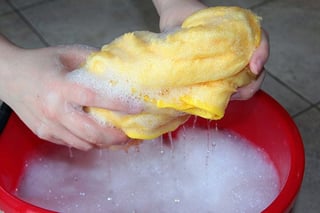 How long do you usually wait until you clean your bathrooms and kitchen sink again? If it's been a while since you've last bent over to scrub out the mold and mildew in your porcelain tub, you could be putting yourself at risk of biofilm. To be clearer, this bacteria is the sticky and slimy goo you find in your tub, shower stall, toilet bowl, tiles, and sink that produces a pinkish color. Have you ever pulled a hairball from your shower drain and seen the ooze that comes up with the hairball? That's biofilm as well. We're here to tell you why you need to rid yourself of it.
How long do you usually wait until you clean your bathrooms and kitchen sink again? If it's been a while since you've last bent over to scrub out the mold and mildew in your porcelain tub, you could be putting yourself at risk of biofilm. To be clearer, this bacteria is the sticky and slimy goo you find in your tub, shower stall, toilet bowl, tiles, and sink that produces a pinkish color. Have you ever pulled a hairball from your shower drain and seen the ooze that comes up with the hairball? That's biofilm as well. We're here to tell you why you need to rid yourself of it.
Hazardous to your Health
For starters, the slimy bacteria is terrible for your health. While we're not asking you to scrub your sinks or tubs daily, we are asking you to take some precaution to the areas in your home that typically interact with water most days. Biofilm is made of multiple species of bacteria and their waste, causing an unpleasant smell to the area. We all know bacteria can cause certain ailments, and this bacteria is no exception as it's been linked to ear infections, Listeria, Salmonella, and E. coli. With biofilm's presence, your kitchen and bathroom are at a greater risk of carrying it. You handle raw chicken in your kitchen, which can easily disperse its disease vectors on your countertops, bowls, chopping boards, and utensils if you're not properly disinfecting them. In your bathrooms, they can sit on counters, towels, tubs, and seat covers. This exact reason is why we can't stress enough the importance of cleaning your bathroom and kitchen often, and properly.
Preventing Biofilm
If you cook regularly, wash clothes regularly, and shower, you have probably been exposed to the bacteria, which we've often confused with mold and mildew. To prevent future problems, be sure to complete the following:
- Use a damp cloth and cleaning solution to wipe off any mildew and mold as they appear on your surfaces
- Scrub the difficult to reach spot with an old toothbrush
- Baking soda is useful for scrubbing off mineral deposits from your fixtures
- Clean your kitchen thoroughly after cooking, especially if you’ve been handling raw meat or eggs
- Try to clean your showers, tubs, sinks, and countertops weekly
- Use bleach on targeted surfaces to remove discolorations caused by the bacteria
- Towel dry your showers and sinks after each use
- After cleaning and disinfecting your sink or toilet, pour ¼ cup of household bleach down the drain and let it sit for no more than 20 minutes (as longer than the allotted time can damage non-porcelain parts of the toilet), then flush several times.
- Clogged drains are a notorious problem because they can belch up water and bacteria that has been harbored deep in your pipes, inaccessible to your cleaning efforts. Make sure to disinfect any surfaces that come in contact with water after a plumbing backup.
Note that almost all of the cleaning materials are regular household items! Check out more simple homemade plumbing repairs.
If you find yourself with a pinkish coloring in your tubs and sinks, follow the tips above to avoid putting yourself at future risks. If you find yourself with a plumbing, water heater, or drain issue, give us a call at (864) 242-5511. We work diligently to keep your home's pipes and drains working properly, and are at your service every day of the year, excluding Christmas. Just click the banner below to schedule a service or contact us online.
If you enjoyed this plumbing article, please check out other posts on our blog and join us on Facebook, Twitter, LinkedIn, and Google+ to see why the Greenville, SC area calls us "The Picky People's Plumber!"

.png)